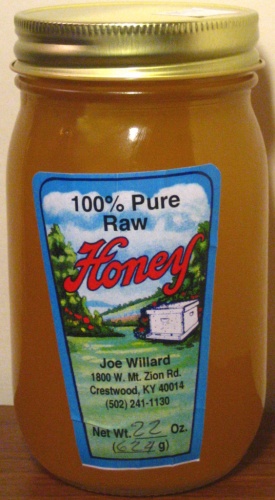Honey has never been a driver for me - I think that a beekeeper who is 'hungry' for honey ends up exploiting the bees in her care - leading to unhealthy hives. Many beekeepers have taken off too much honey to either consume or sell, and then feed the bees high fructose corn syrup or sugar water as an unhealthy, inferior substitute.
Ok - stepping down from the soap box - a surplus of honey can be shared with humans - which is wonderful! By July, the bees had stored over 150 pounds of honey in their hive - wow.
My friend Wendy documented the honey harvest and Rich shared his basement 'brewhouse' space to do the work.
I wanted to find out the simplest, lowest cost way to harvest honey - and after some research online found a wonderful video of the 'crush and strain' method done my 'online mentor' Linda. See here for the video: Linda's Bees.
I first used a bee escape from Brushy Mountain Bee Farm to separate the boxes with honey frames (called honey supers) that I was going to harvest from the rest of the hive. The bee escape allows the bees on the honey supers to move down into the rest of the hive, but not get back up into the honey supers. This worked really well with only a few bees left on the honey supers (vs. thousands) after having it on for a few days. I love this option, as it's chemical free. Often, beekeepers use a chemical to make the bees leave the honey frames.
I pulled 22 frames off of the hive and put them into a plastic bin with a lid (to keep bees from flying back onto the honey frames). I took them around to our screened front porch as a 'holding area' to let any hiding bees fly off before taking them into the house. No stray bees were found!
I had set up a little work area in the basement - with the recommended cardboard to minimize honey tracking everywhere!
Here's the set up:
Plastic bins and nice stock pot - donated from Rich's brewing supplies (many of you know that my husband is a top of the line homebrewer); I used a baking pan to cut the comb from the frames; I bought a bottling pail (which you could make yourself and just buy the 'gate') and 3 mesh filters that fit nicely on the rim of the pail. Total bought was about $45 including the shipping. This was a huge difference from the hundreds of dollars to buy a honey extractor and the other supplies that are often 'needed.'
With my little harvest it was perfect. If I have a larger honey harvest with the addition of hives I'm keeping for others, it could require a bit more of a set up.
Key steps:
 |
| The honey comb has thin caps of wax over each honey cell, which indicates it's finished honey (vs. nectar). |
I used a fork to uncap each side of honey on the frame. I just lightly run the fork down the length of the frame and it nicely breaks the caps to open the cells of honey. After uncapping, I took a sharp knife and cut the comb out of the frame - as I'm doing above. Next year, I'll use a bigger roasting pan - this one was a little too small for the job.
 |
| An action shot taken by Wendy Zent of cutting the comb out of the frame. It was really beautiful. |
This is a pic that shows one of my critical 'learning moments' (trying to forgive myself for screwing up and affecting the hardworking bees). These are comb cells packed with precious pollen. It's different colors from different sources (thanks neighbors!). You can see how it's packed in layers. I should have left the frames that had much pollen in the hive for them. They need this source of protein and nutrition to have healthy brood -esp. as they are building up their hive population for the winter. Now I know. : p
Honey harvest! The bottling gate really makes the job easier and less messy. Otherwise, you would use a soup ladel to get the honey into jars. I ordered sweet little honey jars - but ended up loving the simple jelly jars for my own personal daily honey use. For the experienced beekeeper, you'll have already noticed that the honey is flowing over top of the honey gate. Hee hee hee - when I screwed the honey gate into the hole in the pail, I had wondered if there was a certain way to position it. Of course there was - and I did it upside down! It wasn't that bad - but Rich was a little horrified by the incorrectness of it all.
I'll leave you with one of Wendy's 'art pics' - beautiful chunks of wonderful honey comb.
It felt sacred and celebratory to harvest some of their surplus honey. I think this is the gift to the hobby beekeeper - relishing each moment.










